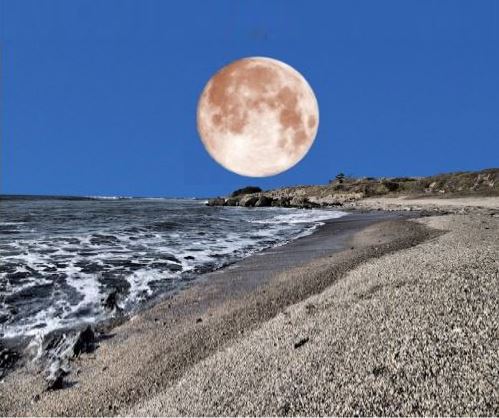A giant supermoon – a once in a lifetime occurrence – will soon appear in the British night sky later this month, astronomers announced. In fact, people all over the world will be able to see it. The Moon only gets this big once every sixty-eight years. The last massive supermoon was observed in the UK in 1948.
Normal supermoons are common occurrences. During the last quarter of this year there will be one each month. However, the Goliath we will be witness to this month is much rarer.
Later this month, the Moon will appear fourteen percent larger in the night sky, and thirty percent brighter.
 The difference in the apparent size of a Supermoon and Micromoon was because on 5th May it was 50,000 km nearer the Earth than on 28th November. In both cases the Moon was the same size, it just appeared larger or smaller. (Image: adapted from apod.nasa.gov)
The difference in the apparent size of a Supermoon and Micromoon was because on 5th May it was 50,000 km nearer the Earth than on 28th November. In both cases the Moon was the same size, it just appeared larger or smaller. (Image: adapted from apod.nasa.gov)
Supermoon on 14th November
According to NASA, the term supermoon originally referred to a new or full moon when our satellite is within 90% of its closest approach to Earth in a given orbit. Today, the term refers more broadly to a full Moon that is nearer to Earth than average.
The giant we will all be able to see on 14th November in the night sky is not only the nearest full Moon of this year, but also the closest full Moon so far in the 21st century. We won’t see one as big again until 25th November, 2034.
The term ‘supermoon’ was coined by astrologer Richard Nolle in 1979, who arbitrarily defined it as:
“A new or full Moon which occurs with the Moon at or near (within 90% of) its closest approach to Earth in a given orbit (perigee). In short, Earth, Moon and Sun are all in a line, with Moon in its nearest approach to Earth.”
What is a supermoon?
A supermoon is when a full moon or new moon is as close to Earth as it can be on its elliptical orbit. This makes it appear much larger and brighter than normal. Scientists call it the Perigee-Syzygy of the Earth-Moon-Sun System.
 The Moon looks larger when it is close to the horizon. It is not bigger. Known as Moon Illusion, it is a psychological trick that affects how we see things. (Image: eyeforlife.com)
The Moon looks larger when it is close to the horizon. It is not bigger. Known as Moon Illusion, it is a psychological trick that affects how we see things. (Image: eyeforlife.com)
The Moon’s distance from our planet varies each month from approximately 222,000 miles (357,000 km) to 252,000 miles (406,000 km), due to its elliptical orbit. ‘Elliptical’ means shaped like an egg.
The opposite is a micromoon, or an Apogee-Syzygy – the term is much less common than supermoon.
The Moon’s association with both oceanic and crustal tides has led to claims that when a supermoon is present, the risk of volcanic eruptions, earthquakes and other events is greater. However, there is no compelling evidence to back these ‘myths’.
You might not notice giant supermoon
Writing in Astronomy Magazine, Richard Talcott explains that although the full moon on 14th November will be considerably larger and brighter than normal, you probably won’t easily notice from a casual glance.
Talcott says that this month’s full Moon will not look all that different from a typical one. The Moon’s apparent diameter will be 33.5 arcminutes (0.56°), which is seven percent larger than normal. It will also be much brighter.
However, these differences are hardly noticeable with the naked eye ‘under the best conditions’, and significantly harder to discern when one tries to compare the Moon’s appearance across a span of several months.
The full Moon always appears larger when it is close to the horizon and our minds compare it with familiar objects. The best time to be impressed is during that moment – when it is near the horizon.
Video – Brightest supermoon in a lifetime
On Monday, 14th November 2016, the Moon will be closer to Earth than it has been for sixty-eight years. We won’t be able to observe such a seemingly massive and bright Moon again until 25th November, 2034.
